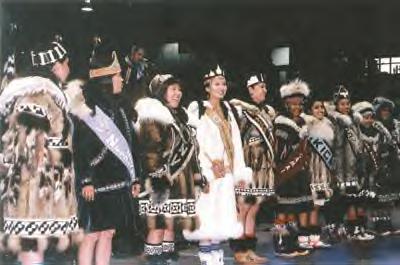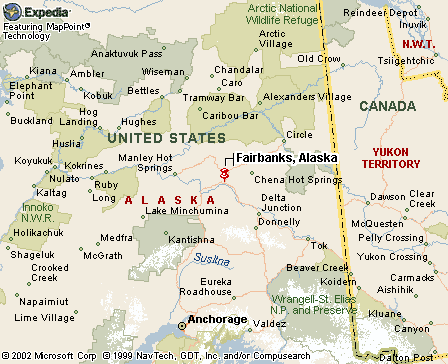|
|
Canku Ota |
|
|
(Many Paths) |
||
|
An Online Newsletter Celebrating Native America |
||
|
August 23, 2003 - Issue 94 |
||
|
|
||
|
World Eskimo-Indian
Olympics |
||
|
by Jack McNeel / Correspondent
/ Indian Country Today
|
||
|
credits: Photo
by Jack McNeel
|
|
Bob Aiken, a respected elder from Barrow stated, "these are the training grounds ... they will use these abilities when they’re out on the ice." The Olympic banner reads "Healthy lifestyles through pride, strength and tradition." There is also the desire to keep the cultures alive and healthy. In listening to the candidates for WEIO Queen, it was immediately apparent that keeping the culture alive is very important to them. Each young lady initially spoke in her Native language and virtually all repeated the desire to pass the traditions learned from their elders on to future generations. Erica Cleavor, 24, Miss Nuchalawoyya, was crowned WEIO Queen for 2003. A graduate of the University of Alaska- Anchorage in social work, she plans to enroll in a master’s program this fall in St. Louis, Mo. while still representing WEIO at shows and events throughout the country. WEIO is also about games and competing and athletes competed in more than 30 events. These events are unique to this region and most have the similar thread of maintaining strength and agility to survive. To use the Eskimo stick pull game as an example, competitors sit facing each other with their feet together and their hands on a short stick. All hands must touch. The contestants then attempt to pull the stick out of the other’s hands. It involves a great deal of hand, leg and back strength and the winner must win two of three attempts. Such strength was necessary when pulling a seal through a breathing hole, critical to survival. Eli Kagak of Barrow won the men’s division. Kagak is a massive man of 400 pounds and appeared to win with ease although he later said, "these guys are getting tougher." He hasn’t lost in this event since 1994 although he missed a couple of years because hunting was good and he needed to stock up on meat for the winter. When asked about his strength, he replied, "I’m a hunter. Just last week we killed eight walrus and throwing those huge slabs of meat into the boats helps make you strong." The Alaskan High Kick is a popular event with spectators. Here, the athlete sits on the floor with one hand holding the opposite foot. The other hand is placed on the floor and supports the weight as the athlete springs up and attempts to kick a ball suspended from a beam. The hand must remain on the floor and they must land in the same position as they start. The person kicking highest is the winner. There is both a men’s and a women’s division in most events, including the high kick. The world record for men is held by Jesse Frankson of Pt. Hope and he duplicated his record of 7’10" again at WEIO. His attempt for 7’11" was high enough but he missed the suspended ball. Another popular spectator event is the Two-Foot High Kick. The competitors must jump with two feet, kick a ball suspended below a beam using both feet, and land on two feet. Again, the one to kick highest is the winner. Phillip Blanchett of Anchorage won with a kick of 7’6", substantially below the world record of 8’8." Historically, leaping into the air and kicking with two feet was a sign in the whaling villages that a whale had been taken. A runner would race toward the village and leap and kick with both feet so the villagers could see the message and prepare to help in beaching the whale. Nicole Johnston won the women’s division for the 16th time in 17 years. Johnston is an amazing athlete in her early 30s who regularly defeats much taller women who are considerably younger. Johnston also won the kneel jump, an event resembling a standing long jump but done from the knees and without the hands touching the floor. The blanket toss is another favorite. The "blanket" is actually a number of bearded seal skins sewn together to form a circle about 10 feet in diameter with a heavy rope laced around the perimeter to allow about 40 people to grasp. These people develop a cadence of pulling and relaxing to raise and lower the competitor standing on the blanket. When the person in charge gives the word, all give a strong pull outward to throw the competitor into the air. The winner is based not only on height but also on form and landing. Some confusion exists on whether this was historically done to get higher and thus see farther or whether it was simply a game of fun. Bob Aiken said the history is from whaling villages where whalers would place the blanket on the ground and dance on it after a successful hunt. A youth movement appeared to be under way in the one-foot high kick where John Miller III, 15, from Barrow kicked 8’6" to defeat the world record holder and Elizabeth Rexford, 17, of Fairbanks kicked 6’ even to win the women’s division. Competitors leap from one foot, kick the ball with the same foot, and also land on that same foot. It’s difficult! There were competitions other than athletic events. The Native baby contest brought exclamations of admiration of their beautiful outfits, often little parkas adorned with a variety of furs and wearing sealskin moccasins. Adults also competed in a regalia contest. Deva Olson and her baby son Leonard from Barrow, were crowd favorites. Each wore beautiful fur parkas and muklucks but also exhibited equally beautiful clothes beneath the parkas. Leonard went through about three reductions in clothes to finally end up with a sealskin vest and pants - plus a small handmade wooden sled to be pulled in. Craft tables were set up above the bleachers surrounding the arena floor. Ivory and whalebone carvings, scrimshaw, sealskin moccasins, Eskimo and Athabaskan dolls and other items seldom seen at shows in the lower 48 states were displayed for sale. |
|
|
www.expedia.com |
|
|
||
|
|
||
| Canku Ota is a free Newsletter celebrating Native America, its traditions and accomplishments . We do not provide subscriber or visitor names to anyone. Some articles presented in Canku Ota may contain copyright material. We have received appropriate permissions for republishing any articles. Material appearing here is distributed without profit or monetary gain to those who have expressed an interest. This is in accordance with Title 17 U.S.C. Section 107. | ||
|
Canku Ota is a copyright © 2000, 2001, 2002, 2003 of Vicki Lockard and Paul Barry. |
||
 |
 |
|
|
The "Canku Ota - A Newsletter Celebrating Native America" web site and its design is the |
||
|
Copyright © 1999, 2000, 2001, 2002, 2003 of Paul C. Barry. |
||
|
All Rights Reserved. |
||
 FAIRBANKS,
Alaska - The 42nd Annual World Eskimo-Indian Olympics (WEIO) was
held July 16 - 19 in Fairbanks. The event was designed to help
maintain traditional activities that were critical to survival
in the harsh environments near the Arctic Ocean. Some activities
were beginning to disappear as lifestyles changed. Abilities were
being lost that could have meant the difference between life and
death on the ice flows off the northern coast of Alaska.
FAIRBANKS,
Alaska - The 42nd Annual World Eskimo-Indian Olympics (WEIO) was
held July 16 - 19 in Fairbanks. The event was designed to help
maintain traditional activities that were critical to survival
in the harsh environments near the Arctic Ocean. Some activities
were beginning to disappear as lifestyles changed. Abilities were
being lost that could have meant the difference between life and
death on the ice flows off the northern coast of Alaska.
